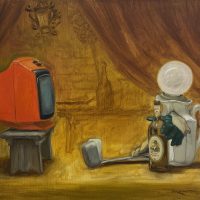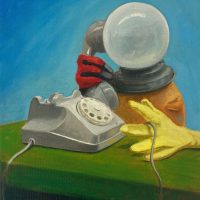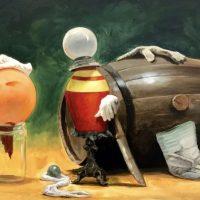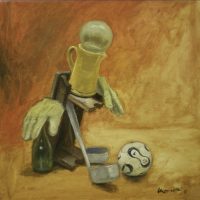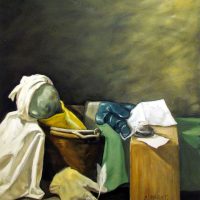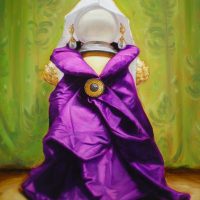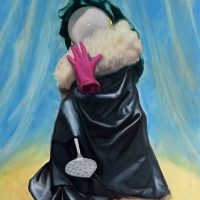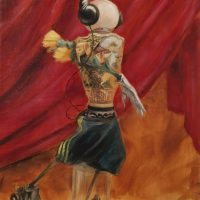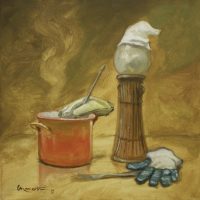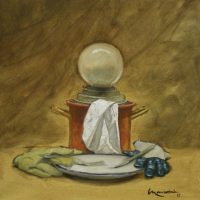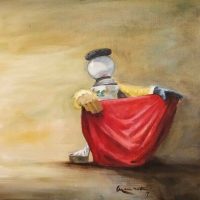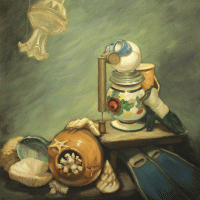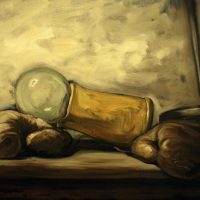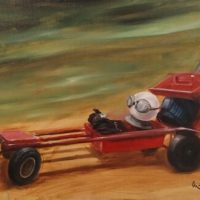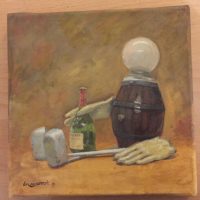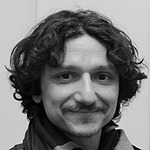
L’immagine seducente di un quadro si esprime attraverso un’infinità di informazioni che creano collegamenti sensoriali nel fruitore che gode dell’esperienza ottica, ma ancor prima nel traduttore-artista, in una visione interiore che riemerge come fusione lavica all’esterno, comprimendo ogni particella di forma e di colore nell’immagine pittorica. Se si condivide il pensiero di R. Arnheim che l’arte è qualcosa che ci soccorre nei momenti di difficoltà ed è strumento che ci aiuta a capire l’umano divenire, così a far fronte agli aspetti terrificanti di tali condizioni, la creazione di questa immagine piena di un ordine denso di significato offre un rifugio dall’insopportabile confusione della realtà esterna. Una sera vidi animarsi su di una piccola sedia un corpo di violino senza testa e mi chiese, con il suo cuore di legno, di bere e di fumare la pipa. Era pronto e aspettava impaziente di essere ritratto nelle sue funzioni che, pacatamente e orgogliosamente, rivestiva in quei giorni di seduta in atelier. Ripeto “rivestiva”, un ruolo come un attore, poiché lo trovai in diversi abiti nei dipinti successivi, come se quelle composizioni che paiono essere l’equivalente di brani di nature morte, in duplice realtà svelavano lo svolgersi di un’azione teatrale. Che paradosso quando mi accorsi che gli stessi oggetti che avevano preso vita nei dipinti rappresentavano l’uomo, che a sua volta li aveva creati un tempo come prodotti per svolgere le diverse attività umane, e che ora si rendevano visibili in piena autonomia muovendosi di loro stessa iniziativa. E queste visioni mnemoniche traslano anche in scene di carattere mitologico come fosse un cordone ombelicale mai reciso dal quale nutrirsi, fonte inesauribile di conoscenza e consapevolezza degli arcani movimenti esistenziali della nostra umanità. Tritoni alati, sirene, fauni e satiri sono visioni interne e ancor più profonde di un mondo già conosciuto dalle prime civiltà, che hanno reso possibile lo specchiarsi nelle acque del mediterraneo come elemento di crescita e di sviluppo culturale e cultuale come dice F. Braudel. Gli oggetti rendono visibile l’uomo, l’uomo rende visibile il mito.
The seductive image of a painting is expressed through a wealth of information that creates sensory connections in the observer who enjoys the optical experience, but first and foremost in the translator-artist, resulting in an inner vision which resurfaces in the form of lava, compressing every form and color particle in the pictorial image. If one agrees with R. Arnheim that art is able to help us in times of trouble and is a resource to get a better understanding of the human changeable condition, so as to face the terrifying aspects inherent in it, the creation of an orderly and meaningful image offers a safe haven from the unbearable havoc of the external reality. One night, on a small chair, I saw the headless body of a violin come to life and ask me, with its wooden heart, to drink and light a pipe. It was ready and impatiently waiting for me to portrait its functions which it performed calmly and proudly during those days of sitting in the studio. I would like to stress that it ‘performed’ a role, just like an actor, for I found it wearing different clothes in later paintings, as if those compositions that seem to be the equivalent of pieces of still life doubled, thus unveiling the unfolding of a theatrical action. What a paradox when I realized that the same objects that had come to life in the paintings actually represented the human being, who in turn had once created them as instruments to perform a range of human activities, and were now fully visible on their own initiative. The same mnemonic visions also shift onto mythological scenes, like an uncut umbilical cord which provides nourishment, an inexhaustible source of knowledge and awareness of the mysterious existential wanderings of humanity. Winged Tritons, mermaids, fauns and satyrs are inner and even more profound visions of a world already known since the earliest civilizations, which have made it possible to be reflected in the waters of the Mediterranean as part of a process of growth and cultural as well as religious development, as stated by F. Braudel. The objects reveal humans, humans reveal the myth

